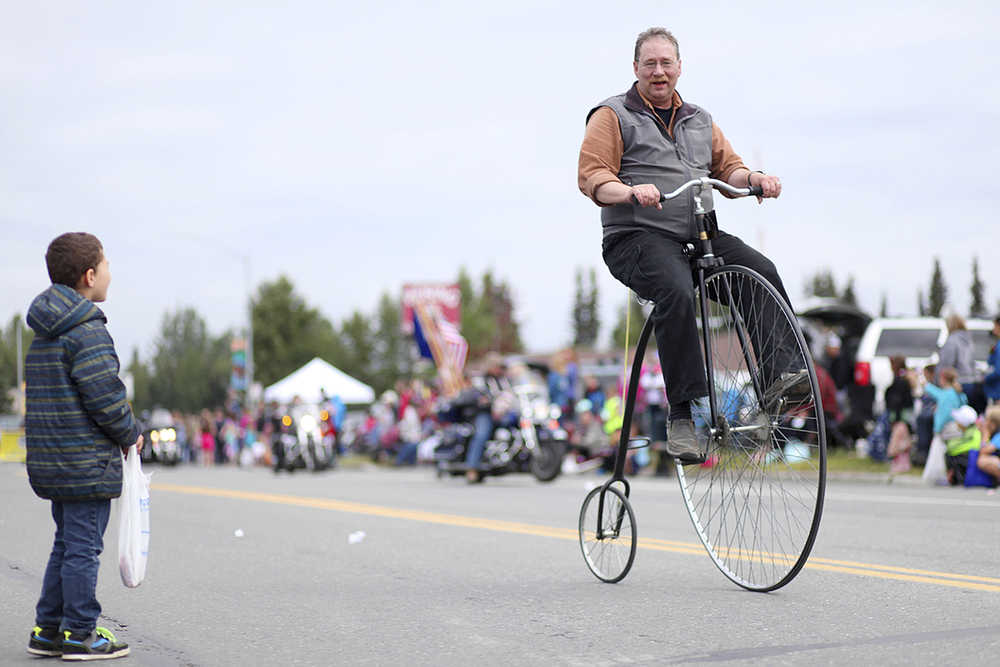KENAI — Doug Field of Kenai recently dusted off his penny-farthing replica for one of its biannual routes in the Kenai Fourth of July parade.
Balancing his weight between the 2-foot, minute back wheel and 4-foot, bulbous front wheel, the seasoned rider hopped on and off the bicycle to demonstrate the dismount, preemptively addressing regular shouts of, “How do you get on? How do you get off? How do you ride that thing?”
“Oh, it is different, it is definitely different,” Field said with a laugh. “One of the major things that is different is that it doesn’t turn on a dime. It doesn’t have any brakes so you really have to watch where you are going, and plan your route. If you are going to make a turn you have to watch where you are going to see what you might run over, who you might run over.”
Field, who is the owner of Kenai Neon Sign Company, also takes the vehicle for a spin at Progress Days, because it is a real crowd pleaser for the parades.
“That is the major reason I enjoy having it and why I like riding it,” Field said. “People love it and it’s fun. It’s a lot of fun to get out there and show people something that they hardly ever see.”
The thin frame is metallic, save two solid tubes of rubber mounted on the wheels, doesn’t encourage recreational rides. Field’s father purchased the bicycle, built by the now out-of-business Boneshaker company, on impulse in San Francisco for $250, which was considered a lot of money in the 1970s. The two trucked the find back up to Alaska, where it has resided ever since.
The penny-farthing was designed after one of the first velocipedes, which are land vehicles made in the early 1800s that require humans to manually power them. Some of the early models called Boneshakers were made of wood or had metal wheels.
The penny-farthing came after and eventually rubber was placed around the wheels preventing extensive rattling.
From personal experience, Field said the rubber is not much of an improvement. The penny-farthing is the predecessor to the modern bicycle, which was perhaps appropriately called the “safety bicycle,” he said.
“Remember the roads were very rough and bumpy back then,” Field said with a laugh. “This one doesn’t go over bumps worth crap, and doesn’t do soft ground. Sand is impossible. It would just stop, and yes I have ridden it through sand.”
Field said he has taken his fair share of falls. He first rode the bicycle when he was about 10 years old, and recalls his feet could barely reach the wheels. He said he has never landed on his side, back or bottom, but has had dire moments where a big jump was necessary to avoid scrapes and scratches.
Field’s father, Bill Field and original owner of Kenai Neon Sign Company, is retired from riding. When he was in possession of the bicycle he would take it out at local events, and even entered it in a local race from Kenai to Soldotna, Field said.
“He only made it a couple of miles but they gave him a certificate for bravery,” he said.
Sometimes Field said he feels the gearless vehicle can really move, but probably doesn’t reach more than 15 mph.
The penny-farthing has required little maintenance throughout the years. Occasionally the spokes need tightening, the handlebars were completely replaced recently and Field’s father once repaired a seam split in the wheel rubber.(backslash)
While he would stop short of calling himself a “penny-farthing expert by any means,” he hasn’t yet met another owner in Alaska.
“I have never talked to anybody that has one, I would be surprised if there was no one else that has one, but probably you could count them on one hand,” Field said.

